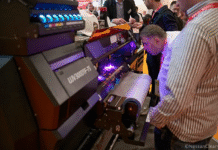
Fujifilm, a major brand in the digital imaging market, participated at the recently concluded CEIF 2019 in Greater Noida. The company’s stand at the exhibition was seen bustling with various programs and interactive sessions with the visitors. “Whenever there is an event in Delhi, there is always a bit of skepticism because this venue is far from the main city. But I think this venue has evolved to an extent where the customers don’t mind traveling all the way,” says SM Ramprasad, assistant vice president of Fujifilm India.
Apart from selling products or launching new products, it is more of a festive atmosphere at the photo exhibition. Fujifilm has over the years come across a lot of customers in India, and with the kind of bonding the company shares with these customers, the event provided a great opportunity to get in touch with prospective customers and also proved to be an exceptional networking platform.
Fujifilm Jet Press 720s aimed at commercial print
Apart from its imaging and inkjet technologies on show, we asked Ramprasad to talk about the B2 format Fujifilm Jet Press 720s, which is a sheetfed inkjet press of interest to commercial and packaging printers as well as to the photo-book market in India. Ramprasad said, “The kind of product the 720s is, it requires certain ROIs for the customer to be completely sure of the product. Currently, we don’t want to sell the 720s press as a product just for the photo applications, or the wedding album segment because that is a market wherein A3 is working exceptionally well. And hence, we want to address this product more to the commercial offset industry.
“In commercial offset, there is a challenge of running cost. Currently, the customer benchmarking is the cost incurred on offset as compared to short-run jobs. There is a point, as of now; if the printers are able to come to a level of say 200 to 500 sheets in the B2 format, the 720s will become economical actually. This short run of 200 to 500 sheets merged with the number of jobs a printer has in a month will be the determining factor. The moment this threshold crosses 1,000 B2 sheets, it becomes easier for customers. Right now, we do have some prospects where we’re working on. But by and large, the running cost is a factor in India as compared to Europe and Japan, which determines the viability of a product here.”
Since there is an element of risk in buying the new Fujifilm Jet Press 720s and achieving the ROI, many of the printers who seem to be interested are actually keen for someone to be the first mover and to prove its viability in the Indian market. Fujifilm India is also keen not to oversell the Jet Press 720s and it appreciates that its customers need to themselves understand both the capabilities of the technology and the opportunities that it represents in the realistic light of the market conditions that they face. Nevertheless, Ramprasad is optimistic considering the number of customers who are seriously interested in buying a B2 format sheetfed inkjet press.















